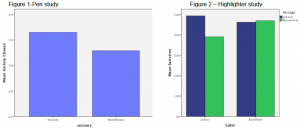Lidan Xu and Dr. Ryan Elder, Department of Business Management
This project is to examine how describing the sensory attributes (vs. non-sensory) of a product impacts variety-seeking behaviors of consumers. It is important to understand when and why consumers seek variety as companies seek to maintain customer loyalty. Prior studies have showed that variety seeking is increased within sensory domains, such as food (Inman, 2001). This current project seeks to understand variety-seeking behaviors within non-sensory product domain. Sensory characteristics lead to quicker satiety than non-sensory characteristics (Inman, 2001). Using the same product over and over again increases the desire for a change. This desire for change, and consequent variety seeking, is especially prevalent with food items, or with items with strong sensory attributes (Inman, 2001). Therefore, we hypothesize that even within nonsensory product domain, describing products in sensorial ways will increase variety-seeking behaviors of consumers.
A pilot study has been conducted in order to understand whether describing a product sensorially vs. non-sensorially lead to more variety-seeking behaviors. We have two sets of pens (including six colors). They are exactly same pens but they are named differently. One set of pens was named sensorially, such as Wild Red Strawberry, Sour Lemon Yellow and Tangerine Orange. The other set of pens was named non-sensorially, such as Razzmatazz Red, Outrageous Orange and Rainslicker Yellow. 193 undergraduate students participated in this study. Participants were randomly assigned to either receiving the sensory named pens or non-sensory named pens. We asked participants to imagine how many different pens they would use within a seven-day period. The result shows that describing pens sensorially increased the variety-seeking behaviors (Meansensorial=3.6 and Meannon-sensorial=3.25). Participants imagined using more variety of pens when the pens are named sensorially (figure 1).
In order to further understand how describing sensory attributes impact the variety-seeking behaviors of consumers and their attitudes toward the products, we conduct the second study. We gave participants yellow highlighters to highlight the articles. The yellow highlighters were named either sensorially (Sour Lemon highlighter) or non-sensorially (Rainslicker highlighter). The articles were either written sensorially (contain more sensory attributes) or non-sensorially. Participants were randomly assigned to one of the four conditions. Participants were instructed to use the highlighter to highlight the article as much as they want. After they highlighted the articles, their attitudes toward the highlight were asked and another pink highlighter was presented to them. They were then asked how much do they desire to switch to the pink highlighter. After the experiment was finished, we counted how many words participants highlighted using the yellow highlighter. Participants were more satiated when they used the sour lemon highlighter (sensory named) to highlight the sensory article and they were more satiated when they used the rainslicker highlighter (non-sensory named) to highlight the non-sensory article (figure 2). However, the level of satiation of using sensory named highlighter was not different from the level of satiation of using non-sensory named highlighter.
The third study was conducted in order to better understand the variety-seeking behaviors of consumers. Participants were asked to imagine using either watermelon paper towel (sensory) or rose paper towel (non-sensory) to clean up spills on the table. The spill was either sensory named (strawberry syrup spill) or non-sensory named (nail polish spill). The images of paper towels and spill were presented to participants. 186 undergraduate participants were randomly assigned into one of the four conditions. We examined their variety seeking behaviors after they viewed the images of paper towels and spill. The result shows that the main effect of the sensory image for the paper towel was moderately significant (P=0.1). Participants seek more variety when they imagined using the sensory named paper towel (watermelon paper towel) than when they imagined using the non-sensory named paper towel (rose paper towel).
In conclusion, three studies show that consumers seek more variety when products are described sensorially. However, the results were not statistically significant. Even though prior study shows that consumers are more likely to seek variety on sensory attributes than on non-sensory attributes (Inman, 2001), the products were primarily in the food domain, which already has very strong sensory attributes (flavors etc.). The literature on sensory-specific satiety describes the phenomenon whereby the pleasantness of food just eaten drops significantly while the pleasantness of uneaten food remains unchanged (Inman, 2001). However, our products were all non-sensory products with very few sensory attributes. Even though we incorporate sensory attributes into those products by describing them sensorially, the sensory attributes we incorporated may not be strong enough to drive people to seek variety. Even though the results were not significant, we believe it is an interesting study that shows that describing non-sensory products sensorially is likely to lead people to seek variety. This project was presented in the Pre-PhD seminar in the Marriott School of Management, and we plan to continue exploring how other factors impact variety seeking.
References
- Inman, J. (2001). The Role of Sensory-Specific Satiety in Attribute-Level Variety Seeking.
Journal of Consumer Research, 28(1), 105-120.

